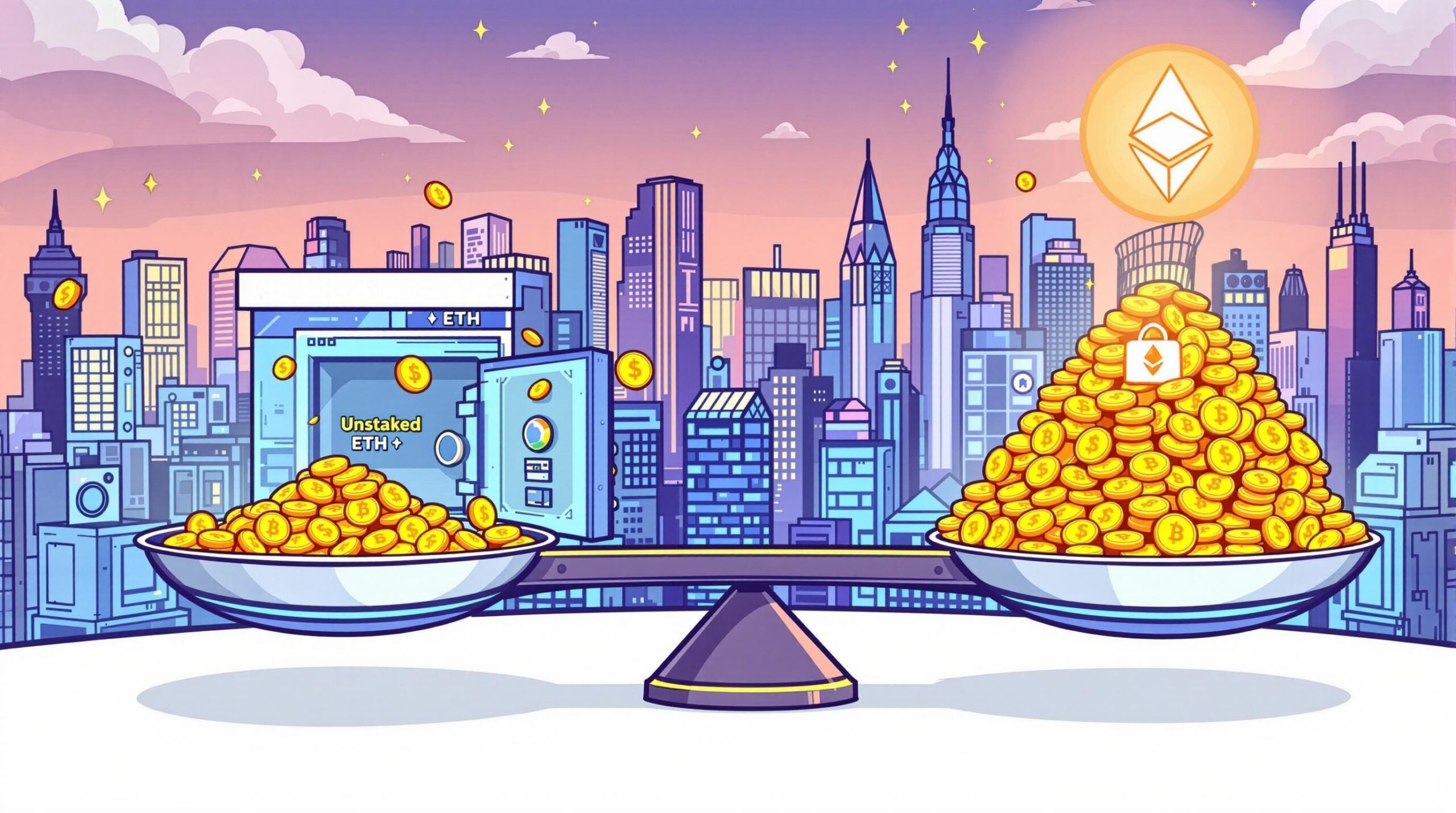BitcoinWorld

Ethereum Staking: Unveiling Resilient Demand Amidst Unstaking Waves
The world of cryptocurrency is a dynamic arena, constantly evolving with shifts in market sentiment and technological advancements. Recently, a significant development in the Ethereum ecosystem has caught the attention of investors and enthusiasts alike: a notable rise in Ethereum (ETH) unstaking. With over 350,000 ETH being withdrawn, some might naturally jump to conclusions about impending selling pressure, especially after Ethereum’s impressive 160% rally since April. However, a closer look at the underlying dynamics reveals a more nuanced and, frankly, encouraging picture for the future of Ethereum staking.
What’s Behind the Recent Surge in Ethereum Unstaking Activity?
The initial reports, highlighted by sources like BeInCrypto, certainly paint a picture of substantial ETH withdrawals. A wave of over 350,000 ETH being unstaked could, at first glance, appear concerning. Many might interpret this as a signal that holders are looking to cash out, especially after a significant price surge. This perspective is understandable, as profit-taking is a common behavior in volatile markets.
However, it’s crucial to delve deeper into the motivations behind these unstaking actions. Is it purely about selling pressure? Not necessarily. A significant portion of this unstaked ETH may not be heading straight to exchanges for immediate sale. Instead, much of it is likely being moved into various treasuries, potentially for long-term strategic allocations, participation in DeFi protocols, or even reallocation to different staking providers offering varied terms or features. This suggests a more sophisticated approach by larger holders and institutions, rather than a simple desire to liquidate assets.
Consider these potential reasons for unstaking:
- Profit Realization: After a substantial rally, some participants may choose to realize a portion of their gains, but this doesn’t always imply a full exit from the ecosystem.
- Rebalancing Portfolios: Large investors often rebalance their portfolios, which might involve moving assets in and out of staking to optimize returns or manage risk across different assets.
- Exploring New Opportunities: The DeFi landscape is constantly innovating. Unstaked ETH might be redeployed into new yield-generating opportunities, liquidity pools, or other decentralized applications.
- Operational Needs: Institutions or large holders might unstake ETH for operational purposes, such as funding new ventures, paying expenses, or meeting regulatory requirements.
This multi-faceted view is vital for understanding the true impact of these withdrawals. It’s not just a binary choice between staking and selling; there’s a spectrum of strategic maneuvers at play.
Why Does Ethereum Staking Demand Remain So Strong?
Despite the unstaking activity, the underlying demand for Ethereum staking remains incredibly robust. This is perhaps the most compelling counter-narrative to any fears of a market downturn stemming from withdrawals. The numbers speak volumes: there’s currently more ETH queued for staking than for unstaking. Furthermore, a staggering 35.7 million ETH is already staked, representing a significant portion of the total circulating supply.
What drives this unwavering confidence in the network and its staking mechanism? Several key factors contribute to this enduring demand:
1. Attractive Yields and Rewards: Validators on the Ethereum network earn rewards for securing the blockchain. These rewards, paid in ETH, offer a compelling passive income stream for stakers, making it an attractive proposition for long-term holders.
2. Network Security and Decentralization: Staking is fundamental to Ethereum’s Proof-of-Stake (PoS) consensus mechanism. By staking ETH, participants contribute directly to the security and decentralization of the network. This commitment by a large number of holders strengthens Ethereum’s resilience against attacks and censorship.
3. Belief in Ethereum’s Future: The Ethereum ecosystem continues to evolve with significant upgrades like the Dencun upgrade focusing on scalability and efficiency. The ongoing development roadmap, aimed at making Ethereum more performant, sustainable, and user-friendly, instills confidence in its long-term viability and growth potential.
4. Institutional Interest: As the crypto market matures, institutional players are increasingly looking for secure and reliable ways to participate. Ethereum staking offers a regulated and structured pathway for institutions to gain exposure to ETH while contributing to network health.
The consistent queue for new staking entries demonstrates a fundamental belief in Ethereum’s value proposition and its role as the foundational layer for a vast decentralized economy. It signals that a significant portion of the market views ETH not just as a speculative asset, but as a productive asset that can generate returns while contributing to a vital global infrastructure.
To illustrate the contrasting trends, consider the following:
| Metric | Observation | Implication |
|---|---|---|
| Recent ETH Unstaking | Over 350,000 ETH withdrawn | Potential profit-taking or strategic reallocations, not necessarily selling. |
| Total Staked ETH | 35.7 million ETH already staked | Demonstrates significant long-term commitment and confidence. |
| Staking vs. Unstaking Queue | More ETH queued for staking than unstaking | Clear indication of net positive demand for staking. |
Navigating the Market: Actionable Insights for Ethereum Holders
Understanding these dynamics is crucial for anyone holding or considering acquiring ETH. The narrative isn’t simply about price action; it’s about the fundamental health and future trajectory of the network. For those interested in Ethereum staking, these insights offer clarity.
- Don’t Panic Over Unstaking: The immediate reaction to large unstaking numbers can be fear. However, as discussed, these withdrawals are often strategic and don’t always equate to selling pressure. Always look for the broader context and data.
- Consider Long-Term Strategy: The strong staking demand suggests a long-term bullish outlook from a significant portion of the market. For individual investors, this reinforces the idea of holding and potentially staking ETH for the long haul, rather than short-term trading.
- Explore Staking Options: If you’re holding ETH, exploring staking opportunities can provide passive income and contribute to the network’s security. Research different staking providers, liquid staking solutions, and the associated risks and rewards.
- Stay Informed on Network Developments: Ethereum’s strength comes from its continuous innovation. Keeping up with upgrades, such as the Dencun upgrade, and the broader roadmap helps in understanding the network’s increasing utility and value.
- Focus on Fundamentals: While market sentiment can be swayed by short-term news, the underlying fundamentals of Ethereum – its robust ecosystem, developer activity, and increasing adoption – are strong. These fundamentals are what truly drive the long-term demand for Ethereum staking.
The Resilient Future of Ethereum Staking
The recent uptick in Ethereum unstaking, while noteworthy, should not overshadow the overarching trend of robust and growing demand for Ethereum staking. The market is demonstrating a clear understanding that not all unstaked ETH is destined for sale. Instead, much of it represents strategic maneuvering by sophisticated participants, while the steady influx of new ETH into staking queues underscores a deep-seated confidence in Ethereum’s long-term vision and its foundational role in the decentralized future.
This dynamic interplay between unstaking and continued staking strength paints a picture of a maturing market, where participants are increasingly sophisticated in their asset management. It reaffirms Ethereum’s position as a critical infrastructure layer, with its community and major holders actively participating in its security and growth through staking. The future of Ethereum staking appears not just stable, but resilient and poised for continued expansion.
In conclusion, while the headline of rising ETH unstaking might initially raise eyebrows, a deeper dive into the data reveals a compelling narrative of sustained confidence and robust demand for Ethereum staking. The network’s foundational strength, coupled with attractive yields and strategic asset management by holders, continues to fuel its growth. This ongoing commitment to securing and participating in the Ethereum network underscores its enduring appeal and its pivotal role in the decentralized economy.
Frequently Asked Questions (FAQs)
Q1: What is Ethereum staking?
Ethereum staking is the process of locking up a certain amount of ETH to help secure the Ethereum blockchain. By doing so, participants (validators) can earn rewards for verifying transactions and creating new blocks on the network, contributing to its Proof-of-Stake consensus mechanism.
Q2: Why are people unstaking ETH if demand for staking is strong?
While some unstaking might be for profit-taking after price rallies, a significant portion is believed to be for strategic reasons. This includes moving ETH to treasuries for long-term strategies, rebalancing portfolios, exploring new DeFi opportunities, or meeting operational needs, rather than immediate selling pressure.
Q3: How much ETH is currently staked?
As of recent reports, over 35.7 million ETH is already staked on the Ethereum network, demonstrating a substantial commitment from its holders and validating its security model.
Q4: Does unstaking ETH always lead to price drops?
Not necessarily. While a large volume of unstaked ETH could theoretically increase selling pressure, the current market dynamics suggest that much of it is being reallocated or held for long-term strategies. The strong demand for new staking also helps absorb potential selling pressure, maintaining network stability.
Q5: What are the benefits of Ethereum staking for an individual investor?
Individual investors can benefit from Ethereum staking through passive income in the form of ETH rewards, contributing to the security and decentralization of the network, and participating in the growth of a leading blockchain ecosystem. Various platforms offer accessible ways to stake ETH, even for smaller amounts.
Did you find this article insightful? Share it with your network and help others understand the true dynamics of Ethereum’s robust ecosystem!
To learn more about the latest Ethereum trends, explore our article on key developments shaping Ethereum price action.
This post Ethereum Staking: Unveiling Resilient Demand Amidst Unstaking Waves first appeared on BitcoinWorld and is written by Editorial Team





